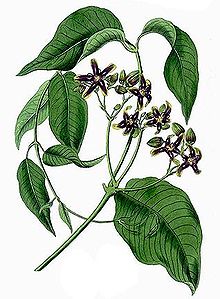Greek tree sling
| Greek tree sling | ||||||||||||
|---|---|---|---|---|---|---|---|---|---|---|---|---|

Greek tree snare ( Periploca graeca ) |
||||||||||||
| Systematics | ||||||||||||
|
||||||||||||
| Scientific name | ||||||||||||
| Periploca graeca | ||||||||||||
| L. |
The Greek tree sling ( Periploca graeca ) is a species of plant of the genus tree slings ( Periploca ) from the subfamily Periplocoideae , which is part of the dog poison family .
features
The Greek tree loop is a deciduous, upright or twining shrub that reaches heights of growth of 5 to 15 meters. The bark is red-brown, partly frosted and cracked.
The simple leaves are opposite , short stalked, 4 to 12 centimeters long and 2 to 7 centimeters wide and ovate to elliptical or lanceolate and entire to sparsely hairy. The upper end is pointed to blunt, sometimes drawn out to a short point, the base is wedge-shaped to rounded. The top of the leaves is shiny and dark green, the underside lighter and bluish green. The leaves are slightly wavy and stay green until the leaves fall in autumn.
The flowers are five-fold, greenish on the outside and dirty purple on the inside. Their diameter is 2 to 2.5 centimeters. They are arranged to 8 to 15 in terminal or axillary clusters . The calyx is bell-shaped and 3 to 5 millimeters long. The calyx lobes are roughly the same as the calyx tube. They are long and hairy on the outside. The petals are 8 to 14 millimeters long and 2 to 3 millimeters wide and only fused together at the base. They are elongated-lanceolate, blunt and turned back at the edge. The upper side is hairy long, especially on the edges, the underside is bald. The tips are spread out like a wheel during the flowering period. The stamens are connected by a wreath at the base. They run out in 5 corolla-like, long, pointed scales and form a small corolla. The stamens are dirty purple, free and meet in an arc over the scar head . The anthers are hairy on the back, have a short appendage and form a unit called the gynostegium with the scar head . 4 pollen grains are glued together to form a unit (tetrad).
The fruit is smooth, brown and consists of 2 carpels that are only fused at the base. Each carpel is 5 to 12 centimeters long, oblong-cylindrical and opens like a belly at the ventral seam. The seeds are 8 to 12 millimeters long, black-brown, oblong-cylindrical and covered with several longitudinal ridges. At the top they have a 25 to 30 millimeter long head of white, silky-gloss hair.
Flowering time is from July to August.
The number of chromosomes is 2n = 22.
Occurrence
The Greek tree loop occurs in the eastern Mediterranean region from Italy eastwards across the Balkans and eastwards to the Caucasus . It grows in alluvial forests, on watercourses, on forest edges and in bushes. It can often be found in maquis . It prefers loose and nutrient-rich soils in warm, sunny locations.
literature
- Gunter Steinbach (Ed.): Shrub trees (Steinbach's natural guide). Mosaik Verlag GmbH, Munich 1996, ISBN 3-576-10560-3 .
Individual evidence
- ^ Periploca graeca at Tropicos.org. In: IPCN Chromosome Reports . Missouri Botanical Garden, St. Louis
